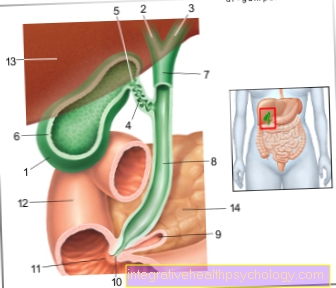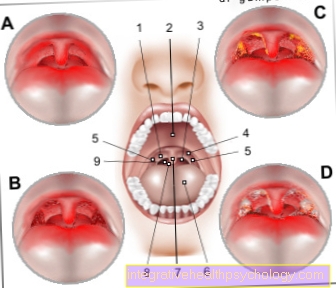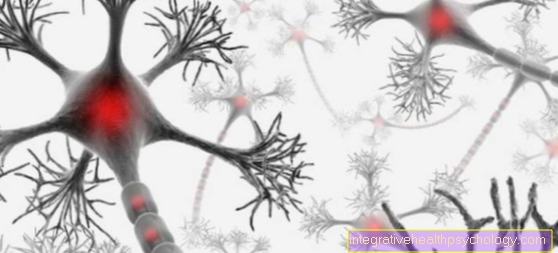Flu virus
Definition - What is the flu virus?
There is actually no such thing as one flu virus. Rather, the triggers of the flu are a whole group of viruses, the so-called influenza viruses types A, B and C.
The individual strains of this virus family differ in terms of their protein content and are also constantly changing them.
The strains are categorized on the basis of their endowment with the two proteins hemaglutinin (H) and neuraminidase (N), which also explains why the bird flu virus was also referred to as H5N1.

For this reason, you can always get infected with the flu and that is why a new vaccination is necessary every year, as the viruses occur in different ways. It should be noted that we are talking about the real flu, influenza.
Influenza infections (colds) are often colloquially referred to as flu, but are caused by completely different pathogens and are usually much more harmless.
Structure of the flu virus
The genes of the flu virus are located on eight individual strands of RNA that form the heart of the virus.
They contain all the information necessary for the virus to replicate and for the production of up to eleven proteins that are required for the virus to function properly.
Together with certain enzyme complexes that are responsible for converting the genes into functional proteins, they are surrounded by a thin lipid shell, which is also known as the virus membrane. So up to this point you can think of the virus as a kind of soap bubble. The virus membrane is interwoven with two types of proteins, hemagglutinin (HA) and neuraminidase (NA), which protrude like spikes from the "soap bubble".
HA enables the virus to attach itself to human cells and penetrate them in order to act as a “parasite” on their metabolic mechanisms - unlike bacteria, viruses are absolutely dependent on this, as they do not have a metabolism of their own. NA, on the other hand, has the function of enabling the viruses newly formed in the human cell to leave the host cell.
You may also be interested in this topic: Viral infection
vaccination
The Robert Koch Institute recommends an annual flu vaccination for people aged 60 and over, employees in health professions and people with chronic illnesses.
The fact that the vaccination has to be carried out annually is due to the fact that there are many different strains of the virus and that these also constantly rewrite their genetic information in order to evade the body's defense mechanisms (see below).
For this reason, a new vaccine is produced every year that provides protection against the most widespread strains that year. The vaccination takes place as a single vaccination in autumn; for children up to the age of 12, the vaccination dose can be divided into two vaccinations about four weeks apart in order to improve the response rate. After the vaccination, the immune system needs about two weeks to build up the vaccination protection.
This works in around 80-90% of those vaccinated. In this context, it should be emphasized: A cold (flu-like infection) is not flu and is caused by other pathogens! As a result, the flu vaccination cannot protect against colds either.
Why do you keep getting the flu?
If you have survived a viral illness, you are in many cases immune to the virus in question afterwards, so you cannot contract the same infection again. In principle, this also applies to the flu virus, but after surviving the flu, you are only immune to the one virus strain that was responsible for the disease.
Unfortunately, as described above, there are numerous different strains of the flu virus, so that you can catch the flu again and again. In addition, the individual strains are also constantly changing their gene code through gene drift and gene shift (see below), so that they are even more difficult to calculate for the immune system.
A flu vaccination, however, has the advantage that it contains the most widespread strains in each autumn, so that the vaccinated person receives broad protection at least for this winter season and his risk of catching the flu can be significantly reduced.
Read more on the subject below: Influenza
Why is the flu wave sometimes worse and sometimes less bad?
The fact that influenza waves turn out very differently from year to year is due to the constant interplay between genetic changes in viruses and the adaptation of the human immune system to these. An example: In one winter there is a particularly severe flu epidemic and a high percentage of the population becomes infected during the winter.
All infected are now immune to the responsible virus strain. If the strain does not undergo any serious genetic changes in the next few months, it will not be able to trigger a particularly bad wave of flu in the following winter, as the majority of people are still immune to it.
The opposite example: The winter is mild and the annual flu wave is very weak, but in the months that follow until the next winter, the responsible virus strain changes considerably due to gene drift and gene shift. Now everyone, including those who were infected with the strain last winter, are at the mercy of the flu again, and the flu wave hits all the more.
Read more on the subject at: Flu complications
Flu virus types
Within the group of influenza viruses, there are three types that can be considered to cause "real" influenza: A, B and C.
While type C only plays a very subordinate role, type B occurs mainly in children and adolescents, but usually only causes relatively mild influenza.
Type A, on the other hand, is to a certain extent the prototype of the flu virus: It is responsible for a large part of real flu illnesses and can sometimes provoke particularly complicated disease courses. The pathogens of the Spanish flu, which caused millions of deaths around the world as part of a pandemic about 100 years ago, for example, belong to type A as well as the bird flu virus H5N1 and the swine flu virus H1N1.
Here a central distinguishing feature of the virus types becomes clear: only viruses of type A can also infect other mammals, while for types B and C humans are the only host.
Read more on the subject at: Bird flu, swine flu
Genetic drift
Influenza virus RNA consists of 8 segments of a long strand, which in turn contains four different bases that alternate in a fixed pattern - the same construction principle as human DNA. When the viruses multiply, their genetic material stored in the RNA must also be replicated.
Errors occasionally occur during the copying and assembly processes for the new RNA, mostly in the form of point mutations. This term describes the incorporation of a single incorrect base into the base sequence of the newly assembled RNA strand. However, in contrast to human cells, viruses do not have the appropriate repair mechanisms to correct the errors. The fact that this is not a disadvantage but rather an advantage for the viruses can be explained as follows: The changed RNA sequence is reflected in a change in the proteins present on the surface of the virus, to which the human immune cells first adjust have to. However, this will take a while.
In this way, genetic drift contributes to the ability of the flu virus to keep one step ahead of the human immune system and thus prevents the development of immunity to the flu.
Genshift
If two influenza viruses of different strains attack a human cell, one or more RNA segments can be exchanged as the viruses multiply.
This genetic recombination can also change the structure of antigens in viruses, i.e. proteins on the surface of viruses that serve as recognition features for human immune cells. For a certain period of time, this modification of their surface proteins means that the viruses are, so to speak, “undercover” and cannot be recognized by the immune system and thus cannot be switched off.
A particularly impressive form of gene shift is the development of completely new subtypes of the influenza virus. Global influenza pandemics usually arise from the gene shift-driven exchange of genes between human and avian (bird-derived) influenza viruses.
The typical way of transmission of the flu virus
Infection with the flu virus is a classic example of a droplet infection. This term describes a transmission path via virus-containing droplets that get into the air or on the hands when sneezing or coughing, for example. If they then quickly get onto the mucous membranes of other people through inhalation or contact of the hands with the mouth, nose or eyes, they can implant themselves in them and the transmission path is complete.
From these considerations, some of the basic rules in the context of a flu wave or in the case of one's own flu can be seen:
Obviously, you should avoid shaking hands as well as other direct physical contact with the sick.
One should avoid particularly bad "virus spreaders" such as doorknobs or handrails in public transport. Regular thorough hand washing is also of central importance. If you have to sneeze or cough, you should not put it in your hand, but in your sleeve or a handkerchief. Regular ventilation also reduces the risk of infection.
How long has the flu virus been contagious?
The tricky thing about the flu virus is that infected people can be contagious up to 24 hours before the first symptoms appear. Those affected do not yet even know that they are carrying the virus and accordingly do not take any measures to contain the spread of the virus. Only when the physical symptoms set in do you start avoiding close physical contact (or even staying at home entirely) or washing your hands more often than usual.
There is then a risk of infection for the entire duration of the illness.
This can only be ruled out 100% after the symptoms have completely subsided, with one restriction: In children and immunocompromised people, there may still be enough viruses to be infected even after the symptoms have disappeared. This circumstance should therefore be taken into account to the extent that the usual precautionary measures should be continued for the groups concerned for at least 24 hours after the symptoms have ceased.
Read more about the topic under flu history
additional InformationFurther information on this topic can be found at:
- flu
- Flu symptoms
- Treating the flu
- Difference between a cold and the flu





























